#En 1868
Explore tagged Tumblr posts
Text
Le vrai Charles Ingalls

#Biographie#Il est le troisième des neuf enfants de Lansford et Laura Ingalls (mais le deuxième#bébé Ingalls#n'a pas vécu)#il était protestant et franc-maçon puis il épousa le 1er février 1860 Caroline Lake Quiner#avec laquelle il eut cinq enfants : Mary#Laura#Carrie#Charles Frederick et Grace.#En 1868#les Ingalls quittèrent Pepin dans le Wisconsin pour s’installer dans le comté de Chariton dans le Missouri.#Un an plus tard#ils s’installèrent à Independence#dans le Kansas#où Laura apprit à écrire.#En 1871#ils retournèrent à Pepin#où Laura et sa sœur Mary furent inscrites à la Barry Corner School.#Au bout de trois ans#ils quittèrent définitivement la ville et partirent pour Walnut Grove#dans le Minnesota. Ils habitèrent d’abord dans une maison creusée dans la berge d’un ruisseau#jusqu’à ce qu’ils eurent fini de construire leur maison.
4 notes
·
View notes
Text

Edouard Vuillard (French, 1868-1940), Le déjeuner du petit Jean Gosset en Normandie [Little Jean Gosset’s lunch in Normandy], 1911. Oil on canvas, 81 x 102 cm.
82 notes
·
View notes
Text







Capitulo 1:ヨーロッパの雰囲気が漂う五稜郭/Goryokaku a hallmark with European airs.
-
Sean bienvenidos a una nueva entrega de cultura e historia japonesa, en este caso vamos a hablar sobre Goryokaku, localizado en Hakodate en la prefectura de Hokkaido al norte de la isla de Honshu.
-
Toponimia de Hokkaido en, el siglo XIX se llamaba Ezo, fue el último reducto del shogunato contra el nuevo orden creando una república (1868-1869). Hay que destacar que Japón estuvo cerrado al mundo durante 260 años de su historia (1603-1868), este periodo se le conoce como periodo Edo, bajo el régimen militar Tokugawa.
-
En 1854 finalizaron los tratados de amistad con Estados Unidos, Gran Bretaña, Rusia. Hakodate se convirtió en una ciudad portuaria abierta al mundo exterior y en 1858, concluyendo el tratado comercial y al año siguiente se convirtió en puerto comercial. Hisaburo Takeda, estudio en Europa y se formó en fortalezas tipo estrelladas de traza italiana, en 1864 se completaron las contribuciones de la fortaleza.
-
Espero que os guste y nos vemos en próximas publicaciones.
-
Welcome to a new installment of Japanese culture and history, in this case we are going to talk about Goryokaku, located in Hakodate in the Hokkaido prefecture north of the island of Honshu.
-
Toponymy of Hokkaido in the 19th century was called Ezo, the last stronghold of the shogunate against the new order creating a republic (1868-1869). It should be noted that Japan was closed to the world for 260 years (1603-1868), this period is known as the Edo period, under the Tokugawa military regime.
-
In 1854 the friendship treaties with the United States, Great Britain, and Russia ended. Hakodate became a port city open to the outside world and in 1858, concluding the commercial treaty and the following year it became a commercial port. Hisaburo Takeda, studied in Europe and trained in Italian star-type fortresses, in 1864 the contributions of the fortress were completed.
-
日本の文化と歴史の新しい記事へようこそ。今回は、本州の北、北海道の函館にある五稜郭について話します。
-
19 世紀の北海道の地名は蝦夷と呼ばれ、共和制を樹立する新秩序(1868~1869 年)に対抗する幕府の最後の拠点でした。 日本は 260 年間 (1603 年から 1868 年まで) 鎖国していたことに注意してください。この期間は、徳川軍事政権下の江戸時代として知られています。
-
1854 年にアメリカ、イギリス、ロシアとの友好条約が終了しました。 函館は対外に開かれた港湾都市となり、1858年に通商条約を締結し、翌年には商業港となりました。 武田久三郎はヨーロッパに留学し、イタリアの星型要塞で訓練を受け、1864 年に要塞の建設を完了しました。
source/ソース:photos internet/写真インターネット
#japan#history#architecture#Hakodate#Hokkaido#republic#unesco#fortitude#geography#perdioedo#Erameiji#archaeology#Goryokaku#日本#歴史#建築#函館#北海道#共和国#ユネスコ#慰霊#地理#永明寺#考古学#五稜郭#Photography#写真#photographers on tumblr#artists on tumblr
414 notes
·
View notes
Text
Jane Avril et Toulouse-Lautrec
L'affiche que l'on aperçoit sur cette colonne Morris dans l'épisode Climatiqueen est une affiche du peintre français Toulouse-Lautrec représentant Jeanne Louise Beaudon, plus connue sous le pseudonyme de Jane Avril.

Jane Avril est née en 1868 à Paris et était l'une des danseuses du Moulin Rouge les plus célèbres de l'époque.


Maltraitée dans sa jeunesse par sa mère, elle sera internée à l'hôpital de la Salpêtrière en 1882 à l'âge de 14 ans et sera diagnostiquée d'une « chorée » : une maladie neurologique qui se manifeste par des mouvements convulsifs et incontrôlables, qu'elle-même appelle la « danse de Saint-Guy » (Au XIXe siècle, l'hôpital était alors l'hospice de la Salpêtrière, un asile pour femmes atteintes d’épilepsie, d’hystérie et de schizophrénie).
Au sein de cet hôpital, Jeanne découvre « le Bal des Folles » : chaque année, la bonne société parisienne s’encanaille le temps d’une soirée en compagnie des patientes internées qui étaient alors exhibées, et paradaient et dansaient en costumes de carnaval. C'est au cours de ce « bal » que Jeanne se découvrira un don et une passion pour la danse.
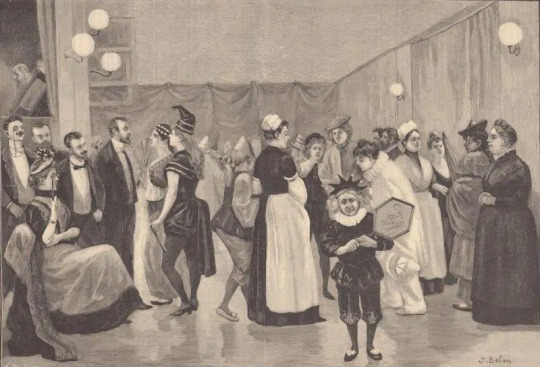
A cette époque, il en fallait peu pour être internée à la Salpêtrière : un mari qui cherche à se débarrasser de son épouse, une santé fragile ou bien un tempérament excentrique... Et sauf exception, on n'en sortait pas. Pour cela, il fallait être déclarée « guérie » par le docteur Jean-Martin Charcot, directeur du « service des hystériques » de l'hôpital et grand fondateur de la neurologie moderne (il a notamment donné son nom à la maladie de Charcot).
Jeanne fait partie des rares femmes à avoir pu quitter cet endroit. Mais elle retombe entre les griffes de sa mère abusive et elle décide de fuguer. Un soir alors qu'elle voulait se jeter dans la Seine pour s'ôter la vie, elle est recueillie in extremis par des prostituées qui la prennent sous leur aile et lui font découvrir le Paris nocturne.
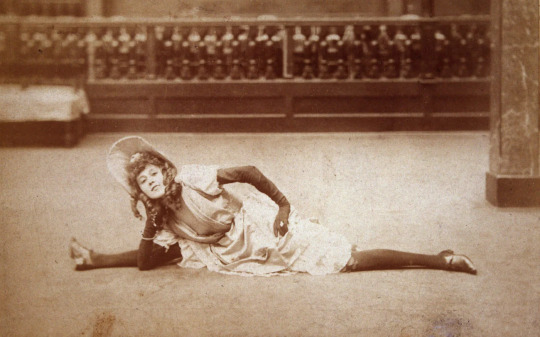
Sous le pseudonyme de Jane Avril, elle commence à danser au Bal Bullier (situé à Paris à l'emplacement de l'actuel Centre sportif universitaire Jean-Sarrailh du CROUS de Paris) avec un style très particulier, entre danse et convulsions épileptiques. Très vite, l’étrange performeuse devient la star du Divan Japonais (l'actuel Divan du Monde), des Folies Bergère et du Moulin Rouge.

Elle fréquente alors les milieux intellectuels et artistiques et fera la connaissance de Henri de Toulouse-Lautrec, un habitué des cabarets où il croque avec talent ce monde nocturne.


Le peintre est séduit par Jane Avril qui deviendra une amie proche : il lui dédie la une du numéro 1 de la revue L’Estampe originale, et il l’illustrera sur de nombreuses affiches et toiles qui feront à la fois la notoriété du peintre et celle de son modèle.


Jane Avril dansera jusqu'à l'âge de 67 ans. Elle décèdera à 74 ans et est enterrée au cimetière du Père-Lachaise.
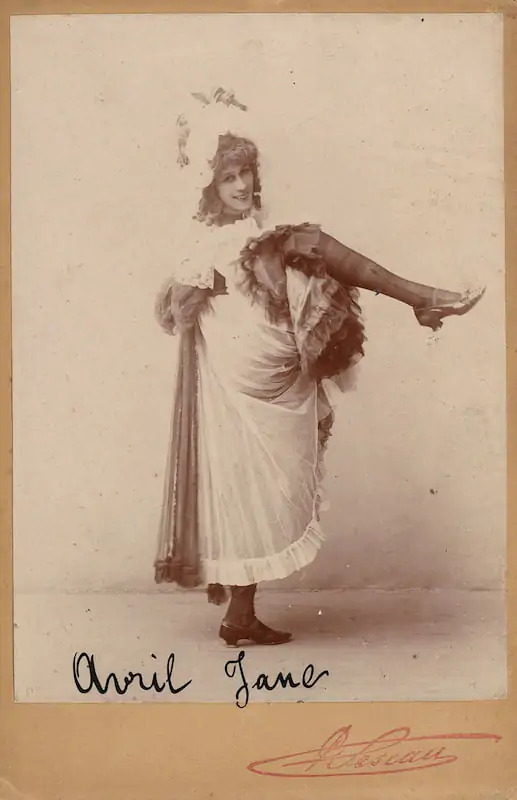
#Miraculous#MLBS6Spoilers#miraculous ladybug#adrien agreste#marinette dupain cheng#ladybug#chat noir#ml analysis#miraculous spoilers#jane avril#toulouse lautrec#miraculous floconfettis#climatiqueen#ml climatiqueen#ml thoughts#colonne morris
45 notes
·
View notes
Text

Thanks to Curieously for sending this fine old 1868 southern mansion in Savannah, Georgia. 6bds, 4.5ba, $5.5M. Do you love the peachy color?


Grand side hall entrance with original stairs.

Walk past the stairs to take the elevator.


The sitting room is the height of elegance with it's carved arch, marble fireplace, wide moldings and floor-to-ceiling windows.

The equally elegant matching dining room.


Cozy den with a fireplace flanked by ceiling-high shelving and a bar with wine racks along an entire wall.


Lovely renovated kitchen in pale gray isn't very large and must be the original kitchen's footprint.

Lovely primary bedroom has a marble fireplace and a door to the terrace.


The en-suite bath reno is a perfect combination of old and new, using reproduction fixtures.

Bedroom #2 is equally beautiful and also has a door to the terrace.

And, it also has an en-suite.

Elegant home office.

Look at this. A full kitchen in this hallway.

Love the exposed brick in this bedroom suite.

What an amazing bedroom. If you use it as a guest room, they'll never leave. It also has a door to the garden.

What could be better than a craft space with exposed brick and plenty of storage.


Bath for this floor.

The terraces are wonderful, aren't they?

Imagine hangin' out here?


Down in the garden. This is gorgeous.

Come down the spiral stairs to sit by the fountain.

You can see the private patio thru the gate, surrounded by a fence and wall.

5,401 sq. ft. lot.
https://www.realtor.com/realestateandhomes-detail/432-Abercorn-St_Savannah_GA_31401_M90444-38759
172 notes
·
View notes
Text




All Photos by Ottavia Baldi
Takagi Shrine 高木神社
Located in Tokyo's Sumida ward
The theme of this shrine is onigiri (rice balls shaped as triangles) which also can be called musubi (which means to tie or to bind - en-musubi).
This is one of the few shrines in Japan dedicated to Takami-Musubi, an androgynous deity of creation and birth, who was born as the second entity in the universe’s history according to Japanese mythology.
However, when the shrine was established in 1468, Takami-Musubi was not the main subject of worship. At this time, Shinto and Buddhism were not yet separated (this would come in 1868) and the shrine was managed by the adjacent Buddhist temple and known as Dairokutensha, dedicated to Dairoku-Tenma-Ō (the Devil King of the Sixth Heaven). This Buddhist devil was known as an evil tempter and deceiver of monks, although there are still multiple shrines or temples to this devil around Japan. Some believe that they may have been influenced by Oda Nobunaga, the most infamous warlord of feudal Japan, who gave himself the moniker of the Devil King to instill fear into his enemies.
88 notes
·
View notes
Text

"Día de invierno, Medevi", 1885 Por Oscar Törn å, pintor de paisajes, ilustrador y artista gráfico sueco (1842-1894) Colección privada De ascendencia francesa, Oscar Törn å comenzó a recibir una educación en los oficios cuando tenía catorce años, pero finalmente mostró una aptitud para el arte. Gracias al apoyo de algunos vecinos acomodados, pudo inscribirse en la Real Academia Sueca de Bellas Artes y participó en la exposición de la Academia de 1868. Fue galardonado con una medalla en 1870 por una de sus primeras pinturas de paisaje. Impaciente por recibir una beca de viaje, despegó por su cuenta en 1873 y se fue a Düsseldorf, pero no estaba contento con sus métodos de enseñanza y más tarde sintió que había perdido su tiempo allí. Finalmente, en 1874, obtuvo una beca Trave y se fue a París vía Bruselas. Sus sentimientos acerca de sus estudios en Alemania fueron confirmados cuando visitó el Salón y estuvo expuesto a los estilos más Naturalistas que prevalecen allí. Durante su primer verano en Francia, vivió en Montigny-sur-Loing y Marlotte, pintando escenas de bosques y ríos. El archipiélago de Estocolmo, Södermanland y Östergötland fueron sus lugares favoritos para pintar. Pequeñas selecciones de su obra pueden verse en el Göteborgs konstmuseum, el Museo Nacional y el Museo Nordiska.
En 1877, exhibió dos pinturas de paisaje en el Salón y recibieron elogios del crítico, Louis Edmond Duranty. Uno fue comprado por Adolphe Goupil. Hizo nuevos viajes de pintura a Marlotte, Nemours y Grez, pero su presentación en el Salón de 1878 no fue tan exitosa. A su regreso a Suecia, inmediatamente organizó una exposición. Esta vez, causó una impresión, ya que la mayoría de los pintores suecos de paisaje seguían haciendo bocetos al aire libre y completando sus pinturas en sus estudios, en lugar de trabajar en plein aire. Varias de sus obras fueron compradas por la Royal Academy para ser utilizadas en material de estudio en sus clases de paisaje. El archipiélago de Estocolmo, Södermanland y Östergötland fueron sus lugares favoritos para pintar. En 1885, se unió a un grupo conocido como los oponentes (Opponenterna) que protestaba contra lo que sentían que eran los métodos anticuados de enseñar en la Royal Academy. Sin embargo, después de participar en una de sus exposiciones, abandonó el grupo porque sentía que era contraproducente. A finales de la década de 1880, una combinación de mala salud y resistencia a nuevos métodos o estilos finalmente redujo la calidad de su trabajo.
#museoparticular#history#arte#artlovers#art#impresionismo#homoerotismo#painting#gayart#art history#artwork#culture#museums#vintage#curators#museum#suecia#estocolmo#Royal Academy
26 notes
·
View notes
Photo

The Aftermath of Nat Turner's Insurrection by John W. Cromwell
John Wesley Cromwell (l. 1846-1927) was an African American civil rights activist, educator, historian, journalist, and lawyer who wrote extensively on slave revolts, especially Nat Turner's Rebellion of 1831. Drawing on primary sources, Cromwell wrote The Aftermath of Nat Turner's Insurrection, published in 1920. The article focuses on the immediate effects of the revolt and its legacy.
Nat Turner's Rebellion
Unknown Artist (Public Domain)
Between 21-23 August 1831, Nat Turner (l. 1800-1831), an educated slave and lay preacher in Southampton County, Virginia, led the deadliest slave rebellion in US history, killing c. 55-65 White people (Cromwell puts the number at 61) before the revolt was put down. Turner escaped capture on 23 August, when his band was defeated by state militia at the Belmont Plantation, and then eluded a manhunt until he was discovered by the farmer Benjamin Phipps on 30 October and delivered to jail in Jerusalem, the county seat, on the 31st. He was tried on 5 November, found guilty, and hanged on 11 November 1831.
While in jail, Turner was interviewed by the attorney T. R. Gray (l. c. 1800-1834), who was not his legal counsel but only an interested party, and Gray's transcript was published in November 1831 as The Confessions of Nat Turner, which became a bestseller. In the Confessions, Turner discusses the inspiration for the revolt and the murders of the citizens of Southampton County once the rebellion was launched. Cromwell adds another dimension to the story by focusing on events in Southampton (and other regions) between 23 August, when the revolt was crushed, and 11 November when Turner was hanged.
The immediate aftermath of Nat Turner's Rebellion (also known as the Southampton Insurrection) was an attack on the Black community – in Southampton and elsewhere – as White citizens feared a large-scale uprising which, they thought, Turner was only one part of.
Cromwell, in describing and explaining the retaliation of the White community, notes the panic that gripped slave-holding states after Turner's revolt and how no one actually knew what was going on or what might come next until Turner's capture and subsequent confession. One of T. R. Gray's stated objectives in publishing the Confessions, in fact, was to assure the White community that Turner had acted alone and there was no need to fear a larger conspiracy of rebel leaders among the slave population. Almost 100 years later, Cromwell's piece describes exactly what that fear looked like and how it was expressed in violence directed at Black people, both slave and free.
John Wesley Cromwell
Simmons & Turner (Public Domain)
Cromwell was a prominent figure in 19th- and 20th-century America, well-versed in history and an eloquent writer and speaker. Editors John B. Duff and Peter M. Mitchell, introducing his piece in their The Nat Turner Rebellion: The Historical Event and the Modern Controversy, write:
John Wesley Cromwell was born a slave in Portsmouth, Virginia . After his father had earned the family's freedom, young Cromwell attended a private school for Negroes in Philadelphia. After teaching in Pennsylvania, he opened a school in Virginia and played a prominent role in the reconstruction politics of the state. Among other activities, Cromwell organized the Union League Clubs, was a member of the jury empaneled to try Jefferson Davis, and served in the Virginia Constitutional Convention, 1867-1868. Subsequently, he practiced law, edited a weekly newspaper, and taught in the public schools of the District of Columbia.
(97)
Having experienced slavery firsthand, Cromwell is sympathetic to Turner's cause and the event itself while acknowledging that, initially at least, the Turner Rebellion did far more harm than good to the Black community of Southampton County and elsewhere. Still, as Cromwell notes, Turner's Revolt also drew greater attention to the "peculiar institution" of slavery, riled up the abolitionists, and contributed to the growing tensions between slave states and free states that would eventually erupt in the American Civil War (1861-1865) and, finally, result in the passage of the Thirteenth Amendment and the end of slavery in the United States.
Text
The following excerpt from John Wesley Cromwell's The Aftermath of Nat Turner's Insurrection (first published in Journal of Negro History 5, April, 1920) is taken from The Nat Turner Rebellion: The Historical Event and the Modern Controversy, edited by John B. Duff and Peter M. Mitchell, pp. 97-112. It has been edited for space; omissions are indicated by ellipses.
A reign of terror followed in Virginia. Labor was paralyzed, plantations abandoned, women and children were driven from home and crowded into nooks and corners. The sufferings of many of these refugees, who spent night after night in the woods, were intense. Retaliation began. In a little more than one day, 120 Negroes were killed. The newspapers of the time contained from day to day indignant protests against the cruelties perpetrated. One individual boasted that he himself had killed between ten and fifteen Negroes. Volunteer whites rode in all directions visiting plantations. Negroes were tortured to death, burned, maimed, and subjected to nameless atrocities. Slaves who were distrusted were pointed out and, if they endeavored to escape, they were ruthlessly shot down.
A few individual instances will show the nature and extent of this vengeance. "A party of horsemen started from Richmond with the intention of killing every colored person they saw in Southampton County. They stopped opposite the cabin of a free colored man who was hoeing in his little field. They called out, 'Is this Southampton County?' He replied, 'Yes, Sir, you have just crossed the line, by yonder tree.' They shot him dead and rode on."
A slaveholder went to the woods accompanied by a faithful slave, who had been the means of saving his master's life during the insurrection. When they reached a retired place in the forest, the man handed his gun to his master, informing him that he could not live a slave any longer, and requested either to free him or shoot him on the spot. The master took the gun, in some trepidation, leveled it at the faithful Negro, and shot him through the heart.
But these outrages were not limited to the Negro population…An Englishman, named Robinson, was engaged in selling books at Petersburg. An alarm being given one night that five hundred blacks were marching against the town, he stood guard with others at the bridge. After the panic had a little subsided, he happened to make the remark that the blacks, as men, were entitled to their freedom and ought to be emancipated. This led to great excitement and the man was warned to leave town. He took passage in the stagecoach, but the vehicle was intercepted. He then fled to a friend's home, but the house was broken open and he was dragged forth. The civil authorities informed of the affair refused to intervene. The mob stripped him, gave him a considerable number of lashes, and sent him on foot naked under a hot sun to Richmond, whence he, with difficulty, found passage to New York.
Believing that Nat Turner's insurrection was a general conspiracy, the people throughout the State were highly excited. . The revolt was subdued, however, before these troops could be placed in action and about all they accomplished thereafter was the terrifying of Negroes who had taken no part in the insurrection and the immolation of others who were suspected.
Sixty-one white persons were killed. Not a Negro was slain in any of the encounters led by Turner. Fifty-three Negroes were apprehended and arraigned. Seventeen of the insurrectionists were convicted, and executed, twelve convicted and transported, ten acquitted, seven discharged, and four sent on to the Superior Court. Four of those convicted and transported were boys. There were brought to trial only four free Negroes, one of whom was discharged and three held for subsequent trial were finally executed. It is said that they were given a decent burial.
The news of the Southampton Insurrection thrilled the whole country, North as well as South. The newspapers teemed with the accounts of it. Rumors of similar outbreaks prevailed all over the State of Virginia and throughout the South. There were rumors to the effect that Nat Turner was everywhere at the same time. People returned to their home before twilight, barricaded themselves in their homes, kept watch during the night, or abandoned their homes for centers where armed force was adequate to their protection. There were many such false reports as the one that two maid servants in Dinwiddie County had murdered an old lady and two children. Negroes throughout the State were suspected, arrested, and prosecuted on the least pretext and in some cases murdered without any cause. Almost any Negro having some of the much-advertised characteristics of Nat Turner was in danger of being run down and torn to pieces for Nat Turner himself…
The excitement in other States was not much less than in Virginia and North Carolina. In South Carolina, Governor Hayne issued a proclamation to quiet rumors of similar uprisings. In Macon, Georgia, the entire population rose at midnight, roused from their beds by rumors of an impending onslaught. Slaves were arrested and tied to trees in different parts of the state, while captains of the militia delighted in hacking at them with swords. In Alabama, rumors of a joint conspiracy of Indians and Negroes found ready credence. At New Orleans, the excitement was at such a height that a report that 1,200 stands of arms were found in a black man's house was readily believed.
But the people were not satisfied with this flow of blood and passions were not subdued with these public wreakings. Nat Turner was still at large. He had eluded their constant vigilance ever since the day of the raid in August. That he was finally captured was more the result of accident than of design.
A dog belonging to some of Nat Turner's acquaintances scented some meat in the cave and stole it one night while Turner was out. Shortly after, two Negroes, one the owner of the dog, were hunting with the same animal. The dog barked at Turner, who had just gone out to walk. Thinking himself discovered, Turner begged these men to conceal his whereabouts, but they, on finding out who it was, precipitately fled.
Concluding from this that they would betray him, Turner left his hiding place, but he was pursued almost incessantly. At one time, he was shot at by one Francis near a fodder stack in a field, but happening to fall at the moment of discharge, the contents of the pistol passed through the crown of his hat. The lines, however, were closing upon Turner. His escape from Francis added new enthusiasm to the pursuit and Turner's resources, as fertile as ever, contrived a new hiding place in a sort of den in the lap of a fallen tree over which he placed fine brush.
He protruded his head as if to reconnoiter about noon, Sunday, October 30, when a Benjamin Phipps, who had that morning for the first time turned out in pursuit, came suddenly upon him. Phipps, not knowing him, demanded, "Who are you?" He was answered, "I am Nat Turner." Phipps then ordered him to extend his arms and Turner obeyed, delivering up a sword which was the only weapon he then had.
This was ten weeks after that Sunday in August . At the time of the capture, there were at least fifty men in search of him, none of whom could have been two miles from the hiding place…His arrest caused much relief. He was taken the next day to Jerusalem, the county seat, and tried on the fifth of November before a board of magistrates. The indictment against him was for making insurrection and plotting to take away the lives of diverse free white persons on the twenty-second of August 1831. On his arraignment, Turner pleaded "Not Guilty." The Commonwealth submitted its case, not on the testimony of any eyewitnesses but on the depositions of one Levi Waller who read Turner's Confession and Colonel Trezevant, the committing magistrate, corroborated it by referring to the same confession. Turner introduced no testimony in defense and his counsel made no argument in his behalf. He was promptly found guilty and sentenced to be hanged Friday, November 11, 1831, twelve days after his capture. During the examination, Nat evinced great intelligence and much shrewdness of intellect, answering every question clearly and distinctly and without confusion or prevarication.
An immense throng gathered on the day of execution, though few were permitted to see the ceremony. He exhibited the utmost composure and calm resignation. Although assured, if he felt it proper, he might address the immense crowd, he declined to avail himself of the privilege, but told the sheriff in a firm voice that he was ready. Not a limb or muscle was observed to move. His body was given over to the surgeons for dissection. He was skinned to supply such souvenirs as purses, his flesh made into grease, and his bones divided as trophies to be handed down as heirlooms. It is said that there still lives a Virginian who has a piece of his skin which was tanned, that another Virginian possesses one of his ears, and that the skull graces the collection of a physician in the city of Norfolk…
So many ills of the Negro followed…that one is inclined to question the wisdom of the insurgent leader…Considered in the light of its immediate effect upon its participants, it was a failure, an egregious failure, a wanton crime. Considered in its necessary relation to slavery and as contributory to making it a national issue by the deepening and stirring of the then-weak local forces, that finally led to the Emancipation Proclamation and Thirteenth Amendment, the insurrection was a moral success and Nat Turner Deserves to be ranked with the greatest reformers of his day.
This insurrection may be considered an effort of the Negro to help himself rather than depend on other human agencies for the protection which could come through his own strong arm; for the spirit of Nat Turner never was completely quelled. He struck ruthlessly, mercilessly, it may be said, in cold blood, innocent women and children; but the system of which he was the victim had less mercy in subjecting his race to the horrors of the "middle passage" and the endless crimes against justice, humanity, and virtue, then perpetrated throughout America. The brutality of his onslaught was a reflex of slavery, the object lesson which he gave brought the question home to every fireside until public conscience, once callous, became quickened, and slavery was doomed.
Continue reading...
22 notes
·
View notes
Text

La Mode illustrée, no. 11, 15 mars 1868, Paris. Chlamydes Kachmir. Collection of the Rijksmuseum, Netherlands
Robe en poult-de-soie brune de deux teintes (étoffe changeante), simplement bordée d'une grosse corde de soie; grande chlamyde-cachemire fond gros bleu à riches dessins orientaux, et frange assortie. Chapeau blanc en tulle, avec fleurs de pommier; brides-écharpes bordées de rouleaux en satin blanc.
Robe en faye gris d'argent, garnie avec trois rouleaux en velours gris qui garnissent le bord inférieur et remontent sur chaque côté d'une rangée de gros boutons en travers en même velours gris; mêmes ornements garnissant les poches, et formant sur le corsage montant une berthe carrée; chlamyde-cachemire fond blanc doublée de soie cerise, avec grands dessins persans et frange assortie. Chapeau en tulle noir moucheté, avec brodes-écharpes fixées sous le menton par un camée de jais; bandeau-diadème en velours noir, avec cinq camées en jais noir; ombrelle pareille à la robe, doublée de taffetas blanc; gants à trois boutons en peau de Suède.
—
Dress in brown poult-de-silk of two shades (changing fabric), simply edged with a thick silk rope; large chlamyde-cashmere (cashmere mantle) on a blue background with rich oriental designs, and matching fringe. White tulle hat, with apple blossoms; scarf straps edged with rolls of white satin.
Dress in silver gray faye, trimmed with three rolls of gray velvet which garnish the lower edge and go up on each side with a row of large buttons across in the same gray velvet; same ornaments garnishing the pockets, and forming a square berthe on the rising bodice; chlamyde-cashmere (cashmere mantle) on a white background lined with cherry silk, with large Persian designs and matching fringe. Hat in speckled black tulle, with embroidered scarves attached under the chin with a jet cameo; black velvet tiara headband, with five black jet cameos; parasol similar to the dress, lined with white taffeta; three-button gloves in suede skin.
#La Mode illustrée#19th century#1860s#1868#on this day#March 15#periodical#fashion#fashion plate#color#description#rijksmuseum#dress#mantle#cape
98 notes
·
View notes
Text

丸葉薄荷[Marubahakka] Mentha suaveolens
丸[Maru] : Round
葉[-ba|Ha] : Leaf
薄荷[Hakka] : Mint
Native to Europe, it was introduced during the Meiji period(1868-1912). Although it has a Japanese name, is commonly called as アップ���ミント[Appuru-minto](Apple mint).
Many mint species are highly fertile, the ones in the photo are also among those that have gone wild. The leaves were somewhat damaged by frost, but there were many of them growing between the rice fields.
Well, maruba, meaning rounded leaf, is also written as 円葉. 円い[Marui] means round, 円[En] means circle. When reading 円 as yen (which we pronounce as en), it means the current currency unit of Japan, but there are several theories as to the origin of this name.
And, 円 is also used as an adjectival verb and is then written usually in hiragana. まどか(円か) is read as madoka, means round or tranquil. For example, まどかな月[Madoka-na tsuki](A round moon), まどかな夢[Madoka-na yume](A peaceful dream), etc. And, つぶら(円ら) is read as tsubura, means round including cuteness. For example, つぶらな瞳[Tsubura-na hitomi](Charming eyes), つぶらな木苺[Tsubura-na kiichigo](A round and lovely raspberry), etc. https://honolulu.emuseum.com/objects/3421/moon-at-magome https://en.wikipedia.org/wiki/Tsuburaya_Productions
15 notes
·
View notes
Text

Georges de Feure (1868-1943) - Femme de buste fumant en profil
Graphite, gouache and watercolour on paper laid down on canvas. 21.25 x 16.75 inches, 54 x 42.3 cm.
Estimate: €30,000-50,000.
Sold Christie's, Paris, 17 Oct 2024 for €52,920 incl B.P.
28 notes
·
View notes
Text
Laura Ingalls Wilder

#Laura Ingalls Wilder#née le 7 février 1867 à Pepin dans le Wisconsin et morte le 10 février 1957 à Mansfield dans le Missouri#est une femme de lettres américaine#auteur de la série de romans pour enfants La Petite Maison dans la prairie#inspirée par sa propre enfance au sein d'une famille de pionniers américains à la fin du xixe siècle. Le succès de cette série de romans a#dont la première a été la série américaine La Petite Maison dans la prairie#dans laquelle l'actrice Melissa Gilbert jouait le rôle de Laura.#Biographie#Fille de Charles et de Caroline Ingalls#Laura Elizabeth Ingalls naquit le 7 février 1867 près de Pepin#dans le Wisconsin. Elle est la deuxième de leurs cinq enfants : Mary#Laura#Carrie#Freddy et Grace. Bien qu’étant une élève intelligente et brillante#son éducation fut sporadique étant donné que sa famille déménagea de nombreuses fois à travers le Midwest et vivait souvent dans des endroi#En 1868#les Ingalls quittèrent Pepin pour s’installer à Chariton County dans le Missouri. Un an plus tard#ils s’installèrent à Independence#dans le Kansas#où Laura apprit à écrire[réf. nécessaire]. En 1871#ils retournèrent à Pepin#où Laura et sa sœur Mary furent inscrites à la Barry Corner School. Au bout de trois ans#ils quittèrent définitivement la ville et partirent pour Walnut Grove#dans le Minnesota. Ils habitèrent d’abord dans une maison creusée dans la berge d’un ruisseau1#jusqu’à ce qu’ils eussent fini de construire leur maison. Ils quittèrent brièvement la ville#de 1876 à 1877#pour vivre à Burr Oak#dans l’Iowa#où Charles Ingalls travailla dans un hôtel puis dans un moulin#puis ils déménagèrent dans le Dakota où ils passèrent leurs hivers en ville
2 notes
·
View notes
Text

Cuno Amiet (28 Mars 1868) "Moon Landscape" 1905
Demain, éclipse partielle solaire visible en France.

7 notes
·
View notes
Text









Sean bienvenidos a una nueva entrega de cultura e historia japonesa; en este caso vamos a hablar sobre Goryokaku, localizado en Hakodate en la prefectura de Hokkaido al norte de la isla de Honshu. - Para proseguir con la aventura, en el capítulo anterior comentamos el origen del nombre de Hokkaido, conocido como Ezo, mencionamos que estuvo 260 años encerrado bajo el shogunato Tokugawa e hicimos mención al tratado de amistad de 1854. - Hay algunos historiadores que consideran la fecha anteriormente mencionada como fin del periodo Edo, pero eso es un gran error y yo discrepo mucho en ello, ya que oficialmente termina en 1868, pero para mí y para algunos pocos sería en 1869 con la república de Ezo liderada por Toshizo Hijikata, quien realizó las obras del castillo Goryokaku de traza italiana. - El Goryokaku se construyó en 1864, para el calendario, japonés (Genji 1) y en 2024 se cumplen 160 años de su construcción. Dicho lugar fue tomado para la película y anime Golden Kamuy. - El Shogunato construyó Goryokaku con el propósito de garantizar el norte y la posterior apertura del puerto, ya a partir de 1857,el cual tardó siete años en completarse. La Oficina del Magistrado de Hakodate fue construida en el centro y está protegida por un foso. Después de ser utilizada como oficina gubernamental durante unos cuatro años, se convirtió en una base para el antiguo ejército del shogunato durante la Guerra de Hakodate, la batalla más decisiva de la Guerra Boshin,fue desmantelado en 1871 (Meiji 4) después de que terminara la guerra. Un tercio del edificio ha sido restaurado en el mismo lugar utilizando el mismo diseño, método de construcción y tamaño,Goryokaku, donde se demolió la oficina del magistrado de Hakodate, el castillo, se abrió al público como Parque Goryokaku en 1914 (Taisho 3). - Espero que os guste y nos vemos en próximas publicaciones y que pasen una feliz Navidad.
Welcome to a new installment of Japanese culture and history; in this case we are going to talk about Goryokaku, located in Hakodate in the Hokkaido prefecture in the north of the island of Honshu.
-
To continue with the adventure, in the previous chapter we discussed the origin of the name of Hokkaido, known as Ezo, we mentioned that it was enclosed for 260 years under the Tokugawa shogunate and we mentioned the friendship treaty of 1854.
-
There are some historians who consider the aforementioned date as the end of the Edo period, but that is a big mistake and I strongly disagree with it, since it officially ends in 1868, but for me and for a few others it would be in 1869 with the Ezo republic led by Toshizo Hijikata, who carried out the works on the Italian-style Goryokaku castle.
-
Goryokaku was built in 1864, according to the Japanese calendar (Genji 1), and 2024 marks the 160th anniversary of its construction. The site was used for the film and anime Golden Kamuy.
Goryokaku was built by the Shogunate for the purpose of securing the north and the subsequent opening of the port, as early as 1857, which took seven years to complete. The Hakodate Magistrate's Office was built in the center and is protected by a moat. After being used as a government office for about four years, it became a base for the former shogunate army during the Hakodate War, the most decisive battle of the Boshin War, and was dismantled in 1871 (Meiji 4) after the war ended. One third of the building has been restored on the same site using the same design, construction method and size.Goryokaku, where the Hakodate magistrate's office was demolished, the castle was opened to the public as Goryokaku Park in 1914 (Taisho 3).
-
I hope you like it and see you in future posts and have a happy Christmas.
-
日本の文化と歴史の新しい記事へようこそ。今回は、本州の北、北海道の函館にある五稜郭について話します。 - 冒険を続けるために、前の章では、蝦夷として知られる北海道の名前の由来について説明し、北海道が 260 年間徳川幕府の下に封鎖されていること、そして 1854 年の友好条約について触れました。 - 前述の日付を江戸時代の終わりと考える歴史家もいますが、それは大きな間違いであり、私はそれに強く反対します。なぜなら、江戸時代の終わりは公式には 1868 年であるからです。しかし、私や少数の人にとっては、それは 1869 年になるでしょう。イタリア式五稜郭の工事を行った土方歳三率いる蝦夷共和国。 - 五稜郭は元治元年(1864)年に建造され、2024年には築160年を迎えます。ここは映画・アニメ『ゴールデンカムイ』の舞台となった場所です。 - 五稜郭は北方の確保とその後の開港を目的として、1857年から幕府が7年の歳月をかけて建設されました。中心部には箱館奉行所が建てられ、堀で守られています。戊辰戦争最大の決戦となった箱館戦争では旧幕府軍の拠点となり、約4年間官庁として使用された後、終戦後の1871年(明治4年)に解体された。 。箱館奉行所城が取り壊された五稜郭は、同じ敷地内に同じ設計・工法・規模で建物の3分の1が復元され、1914年(大正3年)に五稜郭公園として公開されました。 - 気に入っていただければ、今後の投稿でお会いして、メリークリスマスをお過ごしください。
#photo#japan photos#photos#phothography#japanese#japanesehistory#japaneseculture#artjapan#arthistory#日本#ユネスコ#歴史#unesco#考古学#history#japan#archaeology#geography#art#地理#北海道#Hokkaido
111 notes
·
View notes
Text

Maison et Jardins de Georges Clemenceau
Gilbert Bellan
" Bélébat - Le jardin face à la mer "... C'est vers 1925 que le peintre Gilbert Bellan (1868-1951) réalise ce tableau (gouache - aquarelle-fusain) depuis la maison de Georges Clemenceau. L'artiste intègre le cercle de Belébat en 1924. Georges Clemenceau lui demande alors de peindre le ciel et la mer de Belébat, et le vieux chêne vert du bois du Veillon, baptisé «l’Ancêtre». Gilbert Bellan peint et dessine des centaines de vues du lieu.

24 notes
·
View notes
Text


Beautiful 1868 Second Empire Victorian in Southport, Connecticut has 5bds, 5ba, $3.450M (cut by $400K). I'm thinking that the price was cut b/c the outside is so elegant and it has the wonderful mansard roof, but a buyer walks in, expecting to see a spectacular Victorian, they see a completely modernized home.
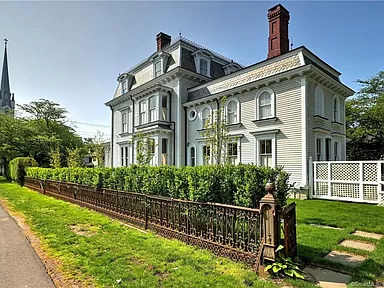
Look at how stately it is, with the original iron fence.


The entrance foyer and the stairs all painted in shades of white, gray, and black. There are still original architectural elements, but the wood is completely painted.

The sitting room is devoid of all character. The floor is a modern dark wood with gray tones.

Here's what they did to the dining room. If you embrace the painted wood and paint or wallpaper the walls, it can look more Victorian.

And, the kitchen. I wonder if a designer did this.

Well, at least the fireplace is still here.
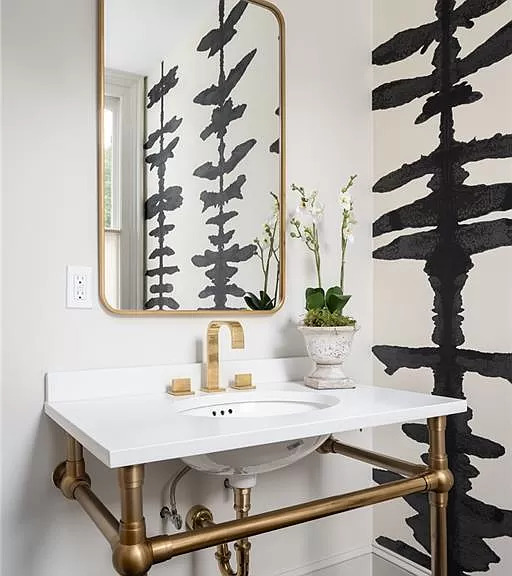
Here is a guest powder room.

The primary bedroom.
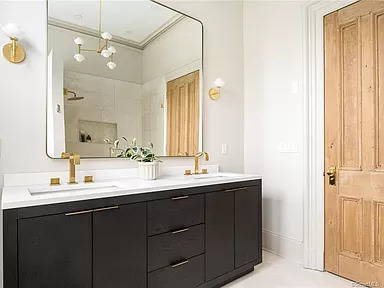
Older homes didn't have en-suite baths, but this home has one for each bedroom.


Most of the en-suites have large walk-in showers and gray sink cabinets.

This bedroom is set up as a home office.


In the finished attic there is a game room that features a batting cage.

In the yard there's a basketball hoop.

Plus a pool with a pergola.

The lot measures .54 acre.
93 notes
·
View notes